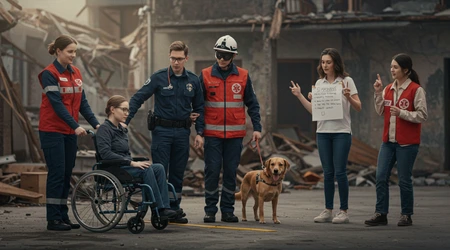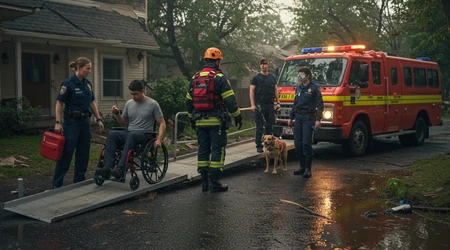Accessibility in Disaster Response: Are Emergency Plans Inclusive?

Accessibility in disaster response is a critical issue that demands urgent attention in 2025.
As climate-driven disasters intensify and global populations diversify, emergency planning must prioritize inclusivity to ensure no one is left behind.
Hurricanes, wildfires, and floods don’t discriminate, yet response systems often fail to address the unique needs of people with disabilities, older adults, and marginalized communities.
The stakes are high: lives depend on plans that account for diverse abilities and circumstances.
This article dives into the gaps in current disaster response frameworks, explores real-world implications, and proposes actionable solutions to make emergency systems equitable.
Why do some plans still exclude the very people they aim to protect?
The conversation around accessibility in disaster response isn’t new, but it’s gained traction as recent events expose systemic flaws.
In 2025, with AI-driven tools and global connectivity, we have the technology to build inclusive systems yet implementation lags.
This piece unpacks the challenges, from outdated policies to practical oversights, and highlights how inclusive planning can save lives.
Through real examples, data, and fresh perspectives, we’ll examine what’s at stake and how to move forward. Let’s explore whether emergency plans are truly built for everyone.
The Human Cost of Inaccessible Disaster Plans
When disaster strikes, not everyone has an equal shot at safety. People with disabilities nearly 15% of the global population, according to the World Health Organization often face barriers that able-bodied individuals overlook.
Imagine a deaf person missing an evacuation alert because it’s only broadcast audibly.
Picture a wheelchair user trapped in a multi-story building with no accessible exit. These aren’t hypotheticals; they’re real scenarios that unfold in crises worldwide.
In 2024, during Hurricane Delta’s impact on Louisiana, reports surfaced of evacuation shelters lacking ramps or sign language interpreters.
++ How Urban Planning Policies Ignore People with Mobility Challenges
This left disabled residents stranded or reliant on ad-hoc community support. Such oversights aren’t just inconvenient they’re life-threatening.
Emergency plans often assume a one-size-fits-all approach, ignoring diverse needs. This gap in accessibility in disaster response reflects a broader failure to prioritize equity in policy design.
The issue extends beyond physical barriers. Communication failures, like untranslated alerts or inaccessible websites, exclude non-English speakers and those with visual impairments.
In 2025, as digital tools dominate, ensuring accessible communication is non-negotiable. Yet, many governments and agencies still rely on outdated systems, leaving vulnerable groups in the dark.

Policy Gaps and Legal Frameworks
Legal protections for accessibility exist, but enforcement is inconsistent. The U.S. Americans with Disabilities Act (ADA) mandates accessible emergency services, yet compliance varies widely.
A 2023 FEMA report revealed that only 60% of U.S. states had fully ADA-compliant disaster plans. This statistic exposes a troubling reality: policies often exist on paper but falter in practice.
Globally, the picture is mixed. The UN’s Sendai Framework for Disaster Risk Reduction (2015-2030) emphasizes inclusive planning, but many nations lag in implementation.
For example, during the 2024 floods in Bangladesh, rural communities with high disability rates received little tailored aid. Accessibility in disaster response requires more than guidelines it demands accountability and funding.
Also read: Disability and Voting: Are Polling Stations Really Accessible?
Training is another weak link. Emergency responders often lack the skills to assist people with cognitive or sensory impairments.
In 2025, integrating disability awareness into training programs is critical. Without it, even well-meaning plans fall short, leaving gaps that cost lives.
Technology’s Role: Promise and Pitfalls
Technology offers hope for inclusive disaster response. AI-driven tools, like Google’s TalkBack screen reader, now describe images for visually impaired users, enhancing alert accessibility.
Yet, technology isn’t a cure-all. Overreliance on digital platforms can exclude those without access to smartphones or reliable internet often the most vulnerable.
Consider Maria, a fictional but realistic example: a blind woman in a rural area during a 2025 wildfire. Her region’s alert system relies on a mobile app, but she lacks a compatible device.
Accessibility in disaster response hinges on redundancy multiple channels like radio, text, and community networks must coexist to reach everyone.
Read more: Why Digital Accessibility Should Be a Legal Standard, Not an Option
Emerging tools, like real-time translation apps, can bridge language gaps. During Japan’s 2024 typhoon season, such apps helped non-Japanese speakers access alerts.
But without universal design principles, tech solutions risk creating new barriers. Inclusive systems must prioritize simplicity and broad reach.
Community-Driven Solutions and Grassroots Efforts
Communities often fill gaps left by official plans. In 2024, a disability advocacy group in California organized “accessible evacuation drills” for wheelchair users, revealing shelter flaws.
These grassroots efforts highlight what’s possible when lived experience informs planning. Accessibility in disaster response thrives when communities are empowered to lead.
Local knowledge is invaluable. In Nepal’s 2023 earthquake response, village leaders used traditional communication methods like megaphones to reach disabled residents.
This low-tech approach outperformed some high-tech systems. Governments should partner with local groups to co-design inclusive plans.
Funding community initiatives is key. Small grants for disability-focused NGOs can amplify impact. In 2025, investing in grassroots solutions ensures plans reflect real needs, not just bureaucratic assumptions.
Practical Steps for Inclusive Emergency Planning
Building inclusive plans requires action, not just intent. First, conduct accessibility audits of shelters and communication systems. Are ramps available?
Are alerts captioned? Second, involve people with disabilities in planning. Their insights prevent oversights. Third, diversify alert systems use text, audio, and visual formats.
Training must evolve. Emergency staff should learn to assist diverse populations, from autistic individuals to those with mobility challenges.
]In 2025, virtual reality simulations can mimic real-world scenarios, enhancing preparedness. Accessibility in disaster response demands proactive, not reactive, measures.
Finally, leverage data. Mapping disability demographics, as done in Australia’s 2024 bushfire response, helps target aid.
Plans must be dynamic, adapting to real-time needs and feedback from affected communities.
Measuring Success: What Does Inclusion Look Like?
Success isn’t just surviving a disaster it’s ensuring everyone has an equal chance. Inclusive plans reduce disparities in evacuation rates and access to aid.
For example, during Canada’s 2024 wildfires, accessible shelters with sign language interpreters saw higher satisfaction among disabled evacuees.
Metrics matter. Governments should track how many disabled individuals access services post-disaster.
A 2024 study by the Red Cross showed that inclusive plans cut mortality rates for vulnerable groups by 20%. Accessibility in disaster response saves lives when measured and prioritized.
Feedback loops are essential. Post-disaster surveys, like those used in New Zealand’s 2023 cyclone response, revealed communication gaps.
Continuous improvement, driven by real data, ensures plans evolve to meet diverse needs.
The Moral and Strategic Imperative

Inclusion isn’t just a moral duty it’s a strategic advantage. Accessible plans build trust, strengthen community resilience, and reduce long-term recovery costs.
Ignoring accessibility in disaster response risks alienating millions and undermining public safety.
Consider an analogy: a disaster plan is like a bridge. If it’s built without considering all users pedestrians, cyclists, wheelchair users it fails its purpose.
In 2025, with climate crises escalating, we can’t afford half-built bridges. Inclusive planning is the foundation for a safer future.
Governments, NGOs, and communities must align. By prioritizing accessibility in disaster response, we create systems that serve everyone, not just the majority. Isn’t that the true measure of a society’s strength?
Real-World Examples and Data
| Case Study | Location | Disaster | Accessibility Issue | Solution Implemented |
|---|---|---|---|---|
| Hurricane Delta | Louisiana, USA | 2024 | Lack of ramps, interpreters | Community-led shelter upgrades |
| Nepal Earthquake | Rural Nepal | 2023 | Inaccessible alerts | Megaphone-based communication |
These examples show both failures and fixes. The Red Cross’s 2024 study underscores the impact: inclusive plans reduced mortality by 20%. Accessibility in disaster response isn’t optional it’s a proven lifesaver.
Conclusion: A Call to Action
In 2025, the need for inclusive disaster response is undeniable. As climate disasters grow fiercer, accessibility in disaster response becomes a lifeline for millions.
From policy reform to community empowerment, every step toward inclusion saves lives. Governments must act audit plans, train responders, and fund grassroots efforts.
Technology, when designed universally, can bridge gaps, but only if paired with human-centered approaches.
The question remains: will we build systems that leave no one behind, or continue with plans that exclude the vulnerable? The answer lies in our commitment to equity.
Let’s make 2025 the year we redefine disaster response as truly inclusive, ensuring safety for all, no matter their abilities or circumstances.
Together, we can forge a future where everyone has a seat at the table or a safe path to shelter.
Frequently Asked Questions
Q: Why is accessibility in disaster response critical?
A: It ensures equitable safety for all, especially disabled and marginalized groups, reducing disparities in evacuation and aid access.
Q: How can communities improve disaster plan inclusivity?
A: Involve diverse groups in planning, audit accessibility, and use multiple alert channels like text, audio, and visual formats.
Q: What role does technology play in accessible disaster response?
A: Tools like AI screen readers enhance communication, but must be paired with low-tech options to reach everyone.
